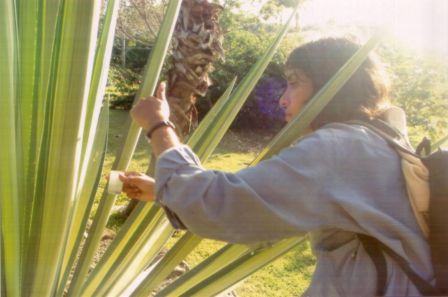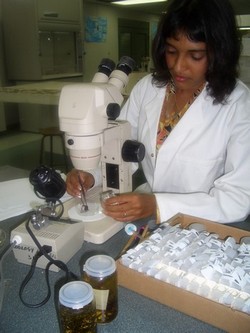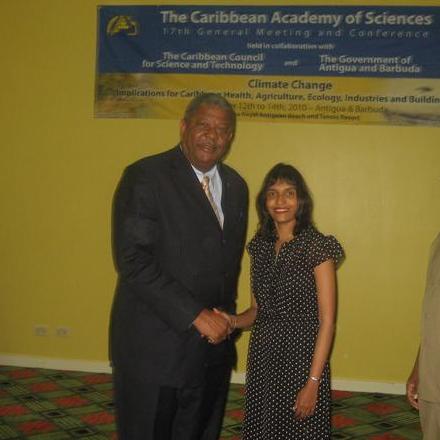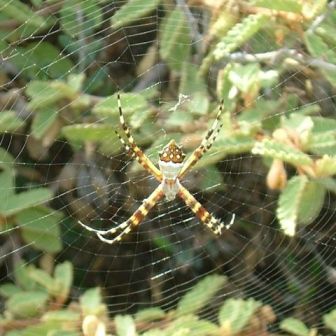 The number of spider species currently known stands at about 40,000 (Platnick, 2007), of a
total of perhaps 170,000 species (Coddington and Levi, 1991). The worldwide spider fauna is thus
still far from completely known, especially in the Neotropics in general, and northern South
America and the Caribbean in particular. The spider fauna has not been documented in print
at the species level for any Caribbean island, though this has been done at the family level
for Trinidad (Sewlal and Cutler, 2003; Cutler, 2005; Sewlal, 2006; Sewlal and Alayón, 2007).
Trinidad is separated from South
America by only 14 km (the southern passage or Serpent's Mouth), and was part of that
continent until the end of the last ice age. Trinidad thus shares a similar climate and biota
with Venezuela and the Guianas, but is a fraction the size making it a much more manageable
area to sample. Knowledge of the spider fauna of Trinidad is therefore of interest as a guide
to the biodiversity in northern South America, and as one of the sources of spiders of the
Windward Islands and the rest of the West Indies. There are currently 46 families and 225
species of spiders known in Trinidad, although the latter is expected to be only a third to
a half of the true total. A complete biodiversity survey of the spiders of Trinidad would be
a very large project. This study therefore focuses on some of the web-building spiders, one of
the three ecological guilds of spiders (the others being long-sighted and short-sighted hunters),
since their webs make detection easier.
The number of spider species currently known stands at about 40,000 (Platnick, 2007), of a
total of perhaps 170,000 species (Coddington and Levi, 1991). The worldwide spider fauna is thus
still far from completely known, especially in the Neotropics in general, and northern South
America and the Caribbean in particular. The spider fauna has not been documented in print
at the species level for any Caribbean island, though this has been done at the family level
for Trinidad (Sewlal and Cutler, 2003; Cutler, 2005; Sewlal, 2006; Sewlal and Alayón, 2007).
Trinidad is separated from South
America by only 14 km (the southern passage or Serpent's Mouth), and was part of that
continent until the end of the last ice age. Trinidad thus shares a similar climate and biota
with Venezuela and the Guianas, but is a fraction the size making it a much more manageable
area to sample. Knowledge of the spider fauna of Trinidad is therefore of interest as a guide
to the biodiversity in northern South America, and as one of the sources of spiders of the
Windward Islands and the rest of the West Indies. There are currently 46 families and 225
species of spiders known in Trinidad, although the latter is expected to be only a third to
a half of the true total. A complete biodiversity survey of the spiders of Trinidad would be
a very large project. This study therefore focuses on some of the web-building spiders, one of
the three ecological guilds of spiders (the others being long-sighted and short-sighted hunters),
since their webs make detection easier.
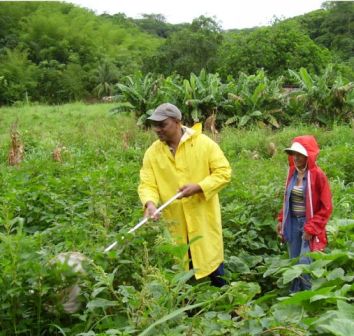 Web-building spiders are defined as those which use their webs primarily to capture prey. They
comprise 15 families and currently 67 known species in Trinidad, still too large a subject for
a comprehensive survey. A subset of this guild has been selected as more manageable, the three
families Araneidae, Nephilidae and Tetragnathidae, which construct orb webs.
Web-building spiders are defined as those which use their webs primarily to capture prey. They
comprise 15 families and currently 67 known species in Trinidad, still too large a subject for
a comprehensive survey. A subset of this guild has been selected as more manageable, the three
families Araneidae, Nephilidae and Tetragnathidae, which construct orb webs.
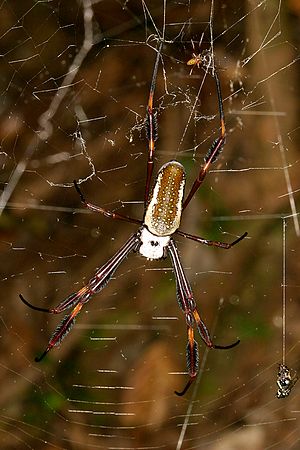 These spiders lead
a rather uniform lifestyle, and regional keys are available for the identification of species
newly discovered in Trinidad.
However, although identification is possible, very little is known
about the natural history of most of the species.
Using this group of spiders, the study will
determine the contribution of habitat to their diversity, including both natural and
man-modified habitats as classified by Beard (1946).
One point of general ecological interest is how
much the diversity of spider faunas will be influenced by taxonomic diversity of the
vegetation.
Spiders are at a higher trophic level to most insects, which are the subject of
most studies of arthropod diversity, and may be less closely related to vegetation
composition than are herbivores; in contrast, structural diversity is predicted to be more
important to spiders. Other questions of interest include diversity in the
monospecies Mora forest (dominated by Mora excelsa) compared to multispecies forests
more typical of tropical areas; the effects of disturbance on diversity in areas of
forest of different logging history; and the diversity and thus conservation value
of more modified habitats. Overall, the study will produce a comprehensive picture of the
biodiversity of orb-weaving spiders in Trinidad in the early 21st Century, as the country embarks on
the path to developed country status ("Vision 2020").
These spiders lead
a rather uniform lifestyle, and regional keys are available for the identification of species
newly discovered in Trinidad.
However, although identification is possible, very little is known
about the natural history of most of the species.
Using this group of spiders, the study will
determine the contribution of habitat to their diversity, including both natural and
man-modified habitats as classified by Beard (1946).
One point of general ecological interest is how
much the diversity of spider faunas will be influenced by taxonomic diversity of the
vegetation.
Spiders are at a higher trophic level to most insects, which are the subject of
most studies of arthropod diversity, and may be less closely related to vegetation
composition than are herbivores; in contrast, structural diversity is predicted to be more
important to spiders. Other questions of interest include diversity in the
monospecies Mora forest (dominated by Mora excelsa) compared to multispecies forests
more typical of tropical areas; the effects of disturbance on diversity in areas of
forest of different logging history; and the diversity and thus conservation value
of more modified habitats. Overall, the study will produce a comprehensive picture of the
biodiversity of orb-weaving spiders in Trinidad in the early 21st Century, as the country embarks on
the path to developed country status ("Vision 2020").
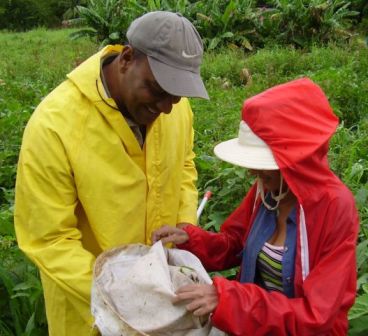 Spiders are sampled using time-based survey methods. The optimum has been found to be a sample
unit comprising one hour of sweep netting in ground vegetation up to shoulder height,
and two hours of visual search for spiders and their webs in accessible locations (but not
under leaf litter, logs or stones (Scharff et al., 2003). Each orb-weaver is collected in a
numbered snap cap vial in 70% ethanol. Details are recorded of web height, web diameter, inclination,
orientation, number of radii, location of web and spider, presence and location of barrier
webs and kleptoparasites, and observations on habitat and behaviour including defence
Spiders are sampled using time-based survey methods. The optimum has been found to be a sample
unit comprising one hour of sweep netting in ground vegetation up to shoulder height,
and two hours of visual search for spiders and their webs in accessible locations (but not
under leaf litter, logs or stones (Scharff et al., 2003). Each orb-weaver is collected in a
numbered snap cap vial in 70% ethanol. Details are recorded of web height, web diameter, inclination,
orientation, number of radii, location of web and spider, presence and location of barrier
webs and kleptoparasites, and observations on habitat and behaviour including defence
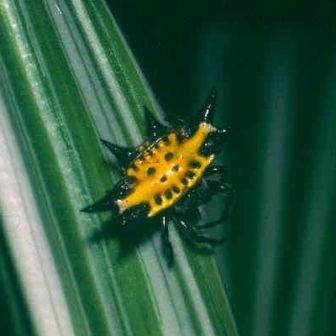 and mating.
Sweep-netting uses a standard insect sweep net, often by an assisting technician.
Spiders are collected in vials of 70% ethanol; or the numbers are recorded where many specimens
of the same species are found. This method also yields nocturnal species which may have
dismantled their webs and are hidden in daytime retreats or among vegetation, avoiding
visual detection. Nocturnal visual search may also be necessary. A further sampling method
makes use of predation of spiders by mud-dauber wasps to provision their nests. Nests of three
species of Tropoxylon are commonly found and will be examined as a source of
orb-weavers. Trap nests of hollow sections of bamboo have been set out (January 2007) in
some areas, to attract a fourth species (T. nitidum), as a check of the coverage of
the other sampling methods.
and mating.
Sweep-netting uses a standard insect sweep net, often by an assisting technician.
Spiders are collected in vials of 70% ethanol; or the numbers are recorded where many specimens
of the same species are found. This method also yields nocturnal species which may have
dismantled their webs and are hidden in daytime retreats or among vegetation, avoiding
visual detection. Nocturnal visual search may also be necessary. A further sampling method
makes use of predation of spiders by mud-dauber wasps to provision their nests. Nests of three
species of Tropoxylon are commonly found and will be examined as a source of
orb-weavers. Trap nests of hollow sections of bamboo have been set out (January 2007) in
some areas, to attract a fourth species (T. nitidum), as a check of the coverage of
the other sampling methods.
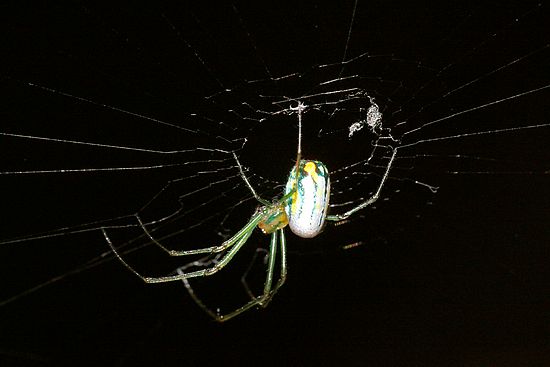 Initial studies were undertaken at three sites in two habitats. These showed that
cumulative species curves levelled off after five 3-hour periods, which is
therefore taken as the standard sampling design for the project. Comparing the three sites
showed more similarity between sites in the same habitat, but still a substantial
difference in the species composition between two sites in Evergreen Seasonal Forest at
Arena (central Trinidad). The project design is therefore for three sites to be sampled for
each habitat type, as far as possible covering the geographical extent of that habitat type
in Trinidad. More replicates are taken if required to answer particular questions, such
as comparison of Mora and more diverse forest types, or man-modified and natural habitats.
The effects of disturbance on diversity will build on existing work in the Victoria-Mayaro
Forest Reserve in southern Trinidad on other taxa. The need for sampling at night, and separately
in the dry and wet seasons, has yet to be determined. Spiders are soft-bodied and cannot
be pinned and dried like other arthropods. Taxonomic analysis in the laboratory therefore
uses alcohol-preserved specimens, a representative sample of which will be retained in the
Land Arthropod Collection of the Department of Life Sciences. Additonal material for
comparison is being collected on surveys of other Caribbean islands, which have been funded
as separate short-term projects (see
www.caribbeanspiders.com).
Initial studies were undertaken at three sites in two habitats. These showed that
cumulative species curves levelled off after five 3-hour periods, which is
therefore taken as the standard sampling design for the project. Comparing the three sites
showed more similarity between sites in the same habitat, but still a substantial
difference in the species composition between two sites in Evergreen Seasonal Forest at
Arena (central Trinidad). The project design is therefore for three sites to be sampled for
each habitat type, as far as possible covering the geographical extent of that habitat type
in Trinidad. More replicates are taken if required to answer particular questions, such
as comparison of Mora and more diverse forest types, or man-modified and natural habitats.
The effects of disturbance on diversity will build on existing work in the Victoria-Mayaro
Forest Reserve in southern Trinidad on other taxa. The need for sampling at night, and separately
in the dry and wet seasons, has yet to be determined. Spiders are soft-bodied and cannot
be pinned and dried like other arthropods. Taxonomic analysis in the laboratory therefore
uses alcohol-preserved specimens, a representative sample of which will be retained in the
Land Arthropod Collection of the Department of Life Sciences. Additonal material for
comparison is being collected on surveys of other Caribbean islands, which have been funded
as separate short-term projects (see
www.caribbeanspiders.com).
Jo-Anne Sewlal collecting a spider in Nevis; examining specimens in the laboratory;
receiving the Caribbean Academy of
Sciences / Third World Academy of Sciences Young Scientist Award 2010 from the Prime Minister of
Antigua and Barbuda the Honourable Baldwin Spencer, 17th Caribbean Academy of Sciences General Meeting,
St. John's Antigua, November 2010.
Funding
-
TT$ 175,260 (3 years), Postgraduate Scholarship, The University of the West Indies, St. Augustine.
-
TT$ 31,117 (2007), Biodiversity survey of the spider families Araneidae, Nephilidae
and Tetragnathidae in Trinidad, West Indies. Research grant, Campus Research and Publication
Fund, The University of the West Indies, St. Augustine.
-
TT$ 27,315 (2008), The Darwin Scholarship Programme. Partial scholarship (75%) to attend
training workshop on Monitoring and Communicating Biodiversity Studies, Field Studies Council,
United Kingdom.
-
TT$ 19,294 (2008), The Darwin Scholarship Programme. Partial funding (25%) and travel expenses
to attend training workshop on Monitoring and Communicating Biodiversity Studies, Shrewsbury, UK.
Travel grant, Campus Research and Publication Fund, The University of the West Indies, St. Augustine.
-
TT$ 9,036 (2009), to attend 33rd meeting of the American Arachnological Society, Arkansas Tech
University, USA. Partial funding, travel grant, Campus Research and Publication
Fund, The University of the West Indies, St. Augustine.
-
US$ 500 (2009), to attend 33rd meeting of the American Arachnological Society, Arkansas Tech
University, USA. Partial funding, American Arachnological Society, USA.
-
TT$ 14,000 (2011), to attend III Congreso Latinoamericano de Aracnologia, Montenegro (Quindio),
Colombia. Partial funding, travel grant, Campus Research and Publication
Fund, The University of the West Indies, St. Augustine.
-
TT$ 4,400 (2011), to attend III Congreso Latinoamericano de Aracnologia, Montenegro (Quindio),
Colombia. Partial funding, departmental funds, Department of Life Sciences,
The University of the West Indies, St. Augustine (surplus returned).
-
TT$ 4,288 (2012), to attend Caribbean Academy of Sciences 18th General Assembly and Biennial Conference,
Cave Hill, Barbados. Travel grant, Campus Research and Publication
Fund, The University of the West Indies, St. Augustine.
-
Funding for surveys of other Caribbean islands, see:
awards.
Supervision
-
Chief supervisor: Prof. Adrian Hailey, Department of Life Sciences, The University of the West
Indies, St. Augustine.
-
Co-supervisor: Dr Bruce Cutler, Microscopy and Analytical Imaging Laboratory,
University of Kansas, Lawrence, Kansas, USA. (Arachnology)
-
Advisor: Dr Mike Oatham, Department of Life Sciences, The University of the West
Indies, St. Augustine. (Habitat ecology)
Results
-
Sewlal, J.N. & Hailey, A. (2016). Abundance, species richness and diversity of the orb-weaving spider
families Araneidae, Nephilidae and Tetragnathidae in natural habitats in Trinidad, West Indies.
J. Nat. Hist. 50: 1687-1698.
journal link
-
Sewlal, J.N. (2015). Possible functions of the detritus stabilimentum and hanging detritus in webs of
Azilia vachoni (Araneae: Tetragnathidae). Arachnology 16: 314-319.
download
-
Sewlal, J.N. & Hailey, A. (2014). Sampling tropical spiders: estimating the biodiversity of the
orb-weaving families Araneidae, Nephilidae and Tetragnathidae in natural and disturbed habitats in Trinidad,
West Indies. Tropical Ecol. 55: 109-117.
download
-
Sewlal, J.N. (2013). Diversity and species composition of the spider fauna of the Aripo Savannas, Trinidad, W.I.
Living World, J. Trinidad Tobago Fld Nat. Club 2013: 42-52.
download
-
Sewlal, J.N. (2012). Observation of apparent “parental care” of eggs by a juvenile Azilia vachoni
(Araneae: Tetragnathidae). Living World, J. Trinidad Tobago Fld Nat. Club 2012: 83-84.
download
-
Sewlal, J.N. (2012). Contribution of Habitat Diversity to the Biodiversity of the Spider Families
Araneidae, Nephilidae and Tetragnathidae in Trinidad, W.I.
Thesis, Department of Life Sciences, The University of the West Indies, St. Augustine, xvii+202 pp. Ph.D. in
Zoology awarded 2013.
-
Sewlal, J.N. (2010). Checklist of orb-weaving spiders of Trinidad and Tobago belonging to the
families Araneidae, Nephilidae and Tetragnathidae. Living World, J. Trinidad Tobago Fld Nat. Club
2010: 67-77.
download
References
Beard, J.S. (1946). The Natural Vegetation of Trinidad. Oxford, Claredon Press.
Coddington, J.A., and Levi, H.W. (1991). Systematics and evolution of spiders. Ann. Rev.
Ecol. Syst. 22: 565-592.
Cutler, B. (2005). Synotaxidae, another Trinidadian Spider (Araneida) Family. Living World,
J. Trinidad Tobago Fld Nat. Club 2005: 49.
Kuznetsova, V., Grozeva, G., Sewlal, J.N. and Nokkala, S. (2007). Karyotype and male
reproductive system in Arachnocoris trinitatus Bergroth. First data on the tribe
Arachnocorini (Heteroptera: Nabidae: Nabinae). Fol. Biol. (Kraków) 55: 17-25.
Platnick, N.I. (2007). The world spider catalog, version 7.5. American Museum of Natural
History, online at
http://research.amnh.org/entomology/spiders/catalog/index.html.
Scharff, N., Coddington, J.A., Griswold, C.E., Horminga, G. and Bjorn, P. (2003).
When to quit? Estimating spider species richness in a northern European deciduous forest.
J. Arachnol. 31: 246-273.
Sewlal, J.N. (2005). Autecology of web-building spiders. M.Phil. thesis, The University of the
West Indies, St. Augustine.
Sewlal, J.N. (2006). Identification of spider families of Trinidad and Tobago, West Indies.
Living World, J. Trinidad Tobago Fld Nat. Club 2006: 44-50.
Sewlal, J.N. and Alayón, G.G. (2007). Four more Trinidadian Spider (Araneida) families.
Living World, J. Trinidad Tobago Fld Nat. Club 2007: 85.
Sewlal, J.N. and Cutler, B. (2003). Annotated List of Spider Families (Araneida) of Trinidad
and Tobago. Living World, J. Trinidad Tobago Fld Nat. Club 2003:
9-13.
Sewlal, J.N. and Starr, C.K. (2008). Observations of the insect Arachnocoris trinitatus
(Heteroptera: Nabidae) as an inquiline in the webs of the spider Mesabolivar aurantiacus
(Araneae: Pholcidae). Carib. J. Sci. 44: 132-135.
* TEDx (an independent event in conjunction with TED Ideas Worth Spreading) which invites
people to talk about their life, career and research to inspire others. TEDxUWI "Caribbean Story"
was held on 17 March 2012 and included speakers from a variety of backgrounds including music,
marketing, architecture and science, who shared their years of experience working and doing
research in the region.
 The number of spider species currently known stands at about 40,000 (Platnick, 2007), of a
total of perhaps 170,000 species (Coddington and Levi, 1991). The worldwide spider fauna is thus
still far from completely known, especially in the Neotropics in general, and northern South
America and the Caribbean in particular. The spider fauna has not been documented in print
at the species level for any Caribbean island, though this has been done at the family level
for Trinidad (Sewlal and Cutler, 2003; Cutler, 2005; Sewlal, 2006; Sewlal and Alayón, 2007).
Trinidad is separated from South
America by only 14 km (the southern passage or Serpent's Mouth), and was part of that
continent until the end of the last ice age. Trinidad thus shares a similar climate and biota
with Venezuela and the Guianas, but is a fraction the size making it a much more manageable
area to sample. Knowledge of the spider fauna of Trinidad is therefore of interest as a guide
to the biodiversity in northern South America, and as one of the sources of spiders of the
Windward Islands and the rest of the West Indies. There are currently 46 families and 225
species of spiders known in Trinidad, although the latter is expected to be only a third to
a half of the true total. A complete biodiversity survey of the spiders of Trinidad would be
a very large project. This study therefore focuses on some of the web-building spiders, one of
the three ecological guilds of spiders (the others being long-sighted and short-sighted hunters),
since their webs make detection easier.
The number of spider species currently known stands at about 40,000 (Platnick, 2007), of a
total of perhaps 170,000 species (Coddington and Levi, 1991). The worldwide spider fauna is thus
still far from completely known, especially in the Neotropics in general, and northern South
America and the Caribbean in particular. The spider fauna has not been documented in print
at the species level for any Caribbean island, though this has been done at the family level
for Trinidad (Sewlal and Cutler, 2003; Cutler, 2005; Sewlal, 2006; Sewlal and Alayón, 2007).
Trinidad is separated from South
America by only 14 km (the southern passage or Serpent's Mouth), and was part of that
continent until the end of the last ice age. Trinidad thus shares a similar climate and biota
with Venezuela and the Guianas, but is a fraction the size making it a much more manageable
area to sample. Knowledge of the spider fauna of Trinidad is therefore of interest as a guide
to the biodiversity in northern South America, and as one of the sources of spiders of the
Windward Islands and the rest of the West Indies. There are currently 46 families and 225
species of spiders known in Trinidad, although the latter is expected to be only a third to
a half of the true total. A complete biodiversity survey of the spiders of Trinidad would be
a very large project. This study therefore focuses on some of the web-building spiders, one of
the three ecological guilds of spiders (the others being long-sighted and short-sighted hunters),
since their webs make detection easier.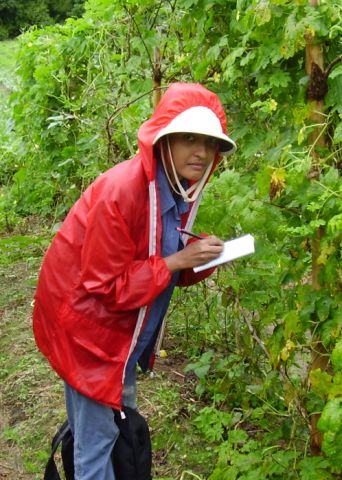
 Web-building spiders are defined as those which use their webs primarily to capture prey. They
comprise 15 families and currently 67 known species in Trinidad, still too large a subject for
a comprehensive survey. A subset of this guild has been selected as more manageable, the three
families Araneidae, Nephilidae and Tetragnathidae, which construct orb webs.
Web-building spiders are defined as those which use their webs primarily to capture prey. They
comprise 15 families and currently 67 known species in Trinidad, still too large a subject for
a comprehensive survey. A subset of this guild has been selected as more manageable, the three
families Araneidae, Nephilidae and Tetragnathidae, which construct orb webs.
 These spiders lead
a rather uniform lifestyle, and regional keys are available for the identification of species
newly discovered in Trinidad.
However, although identification is possible, very little is known
about the natural history of most of the species.
Using this group of spiders, the study will
determine the contribution of habitat to their diversity, including both natural and
man-modified habitats as classified by Beard (1946).
One point of general ecological interest is how
much the diversity of spider faunas will be influenced by taxonomic diversity of the
vegetation.
Spiders are at a higher trophic level to most insects, which are the subject of
most studies of arthropod diversity, and may be less closely related to vegetation
composition than are herbivores; in contrast, structural diversity is predicted to be more
important to spiders. Other questions of interest include diversity in the
monospecies Mora forest (dominated by Mora excelsa) compared to multispecies forests
more typical of tropical areas; the effects of disturbance on diversity in areas of
forest of different logging history; and the diversity and thus conservation value
of more modified habitats. Overall, the study will produce a comprehensive picture of the
biodiversity of orb-weaving spiders in Trinidad in the early 21st Century, as the country embarks on
the path to developed country status ("Vision 2020").
These spiders lead
a rather uniform lifestyle, and regional keys are available for the identification of species
newly discovered in Trinidad.
However, although identification is possible, very little is known
about the natural history of most of the species.
Using this group of spiders, the study will
determine the contribution of habitat to their diversity, including both natural and
man-modified habitats as classified by Beard (1946).
One point of general ecological interest is how
much the diversity of spider faunas will be influenced by taxonomic diversity of the
vegetation.
Spiders are at a higher trophic level to most insects, which are the subject of
most studies of arthropod diversity, and may be less closely related to vegetation
composition than are herbivores; in contrast, structural diversity is predicted to be more
important to spiders. Other questions of interest include diversity in the
monospecies Mora forest (dominated by Mora excelsa) compared to multispecies forests
more typical of tropical areas; the effects of disturbance on diversity in areas of
forest of different logging history; and the diversity and thus conservation value
of more modified habitats. Overall, the study will produce a comprehensive picture of the
biodiversity of orb-weaving spiders in Trinidad in the early 21st Century, as the country embarks on
the path to developed country status ("Vision 2020").
 Spiders are sampled using time-based survey methods. The optimum has been found to be a sample
unit comprising one hour of sweep netting in ground vegetation up to shoulder height,
and two hours of visual search for spiders and their webs in accessible locations (but not
under leaf litter, logs or stones (Scharff et al., 2003). Each orb-weaver is collected in a
numbered snap cap vial in 70% ethanol. Details are recorded of web height, web diameter, inclination,
orientation, number of radii, location of web and spider, presence and location of barrier
webs and kleptoparasites, and observations on habitat and behaviour including defence
Spiders are sampled using time-based survey methods. The optimum has been found to be a sample
unit comprising one hour of sweep netting in ground vegetation up to shoulder height,
and two hours of visual search for spiders and their webs in accessible locations (but not
under leaf litter, logs or stones (Scharff et al., 2003). Each orb-weaver is collected in a
numbered snap cap vial in 70% ethanol. Details are recorded of web height, web diameter, inclination,
orientation, number of radii, location of web and spider, presence and location of barrier
webs and kleptoparasites, and observations on habitat and behaviour including defence
 and mating.
Sweep-netting uses a standard insect sweep net, often by an assisting technician.
Spiders are collected in vials of 70% ethanol; or the numbers are recorded where many specimens
of the same species are found. This method also yields nocturnal species which may have
dismantled their webs and are hidden in daytime retreats or among vegetation, avoiding
visual detection. Nocturnal visual search may also be necessary. A further sampling method
makes use of predation of spiders by mud-dauber wasps to provision their nests. Nests of three
species of Tropoxylon are commonly found and will be examined as a source of
orb-weavers. Trap nests of hollow sections of bamboo have been set out (January 2007) in
some areas, to attract a fourth species (T. nitidum), as a check of the coverage of
the other sampling methods.
and mating.
Sweep-netting uses a standard insect sweep net, often by an assisting technician.
Spiders are collected in vials of 70% ethanol; or the numbers are recorded where many specimens
of the same species are found. This method also yields nocturnal species which may have
dismantled their webs and are hidden in daytime retreats or among vegetation, avoiding
visual detection. Nocturnal visual search may also be necessary. A further sampling method
makes use of predation of spiders by mud-dauber wasps to provision their nests. Nests of three
species of Tropoxylon are commonly found and will be examined as a source of
orb-weavers. Trap nests of hollow sections of bamboo have been set out (January 2007) in
some areas, to attract a fourth species (T. nitidum), as a check of the coverage of
the other sampling methods. Initial studies were undertaken at three sites in two habitats. These showed that
cumulative species curves levelled off after five 3-hour periods, which is
therefore taken as the standard sampling design for the project. Comparing the three sites
showed more similarity between sites in the same habitat, but still a substantial
difference in the species composition between two sites in Evergreen Seasonal Forest at
Arena (central Trinidad). The project design is therefore for three sites to be sampled for
each habitat type, as far as possible covering the geographical extent of that habitat type
in Trinidad. More replicates are taken if required to answer particular questions, such
as comparison of Mora and more diverse forest types, or man-modified and natural habitats.
The effects of disturbance on diversity will build on existing work in the Victoria-Mayaro
Forest Reserve in southern Trinidad on other taxa. The need for sampling at night, and separately
in the dry and wet seasons, has yet to be determined. Spiders are soft-bodied and cannot
be pinned and dried like other arthropods. Taxonomic analysis in the laboratory therefore
uses alcohol-preserved specimens, a representative sample of which will be retained in the
Land Arthropod Collection of the Department of Life Sciences. Additonal material for
comparison is being collected on surveys of other Caribbean islands, which have been funded
as separate short-term projects (see
Initial studies were undertaken at three sites in two habitats. These showed that
cumulative species curves levelled off after five 3-hour periods, which is
therefore taken as the standard sampling design for the project. Comparing the three sites
showed more similarity between sites in the same habitat, but still a substantial
difference in the species composition between two sites in Evergreen Seasonal Forest at
Arena (central Trinidad). The project design is therefore for three sites to be sampled for
each habitat type, as far as possible covering the geographical extent of that habitat type
in Trinidad. More replicates are taken if required to answer particular questions, such
as comparison of Mora and more diverse forest types, or man-modified and natural habitats.
The effects of disturbance on diversity will build on existing work in the Victoria-Mayaro
Forest Reserve in southern Trinidad on other taxa. The need for sampling at night, and separately
in the dry and wet seasons, has yet to be determined. Spiders are soft-bodied and cannot
be pinned and dried like other arthropods. Taxonomic analysis in the laboratory therefore
uses alcohol-preserved specimens, a representative sample of which will be retained in the
Land Arthropod Collection of the Department of Life Sciences. Additonal material for
comparison is being collected on surveys of other Caribbean islands, which have been funded
as separate short-term projects (see 